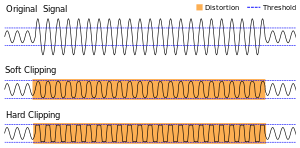Limiter

In electronics, a limiter is a circuit that allows signals below a specified input power or level to pass unaffected while attenuating the peaks of stronger signals that exceed this threshold. Limiting is a type of dynamic range compression. Clipping (audio) is an extreme version of limiting.
Limiting is any process by which a specified characteristic (usually amplitude) of the output of a device is prevented from exceeding a predetermined value.
Limiters are common as a safety device in live sound and broadcast applications to prevent sudden volume peaks from occurring. Limiters are also used as protective features in some components of sound reinforcement systems (e.g., powered mixing boards and power amplifiers) and in some bass amps, to prevent unwanted distortion or speaker damage.
Types
Limiting can refer to non-linear clipping, in which a signal is passed through normally but "sheared off" when it would normally exceed a certain threshold. It can also refer to a type of variable-gain audio level compression, in which the gain of an amplifier is changed very quickly to prevent the signal from going over a certain amplitude.
- Hard limiting ("clipping") is a limiting action in which there is
- (a) over the permitted dynamic range, negligible variation in the expected characteristic of the output signal, and
- (b) a steady-state signal, at the maximum permitted level, for the duration of each period when the output would otherwise be required to exceed the permitted dynamic range in order to correspond to the transfer function of the device.
- Soft limiting is limiting in which the transfer function of a device is a function of its instantaneous or integrated output level. The output waveform is therefore distorted, but not clipped.
In amplifiers
Bass instrument amplifiers and power amplifiers are more commonly equipped with limiter circuitry to prevent overloading the power amplifier and to protect speakers. Electric guitar amps do not usually have limiters.
PIN diodes can be used in limiter circuits to reflect the energy back to the source or clip the signal.[1]
In FM radio
An FM radio receiver usually has at least one stage of amplification for this purpose. It provides a constant level of signal to the FM demodulator stage, reducing the effect of signal level changes in the output. If two or more signals are received at the same time, a high performance limiter stage can greatly reduce the effect of the weaker signals on the output. This is commonly referred to as the FM capture effect.
Generally, FM demodulators are not affected by amplitude variations, since the baseband is contained in the frequency deviations. Some detectors, including the ratio detector, inherently limit gain by a nature of the circuit design. In AM radio, the intelligence is located in the amplitude variations, and distortion can occur due to spurious signals that could cause the baseband to be misrepresented.
In audio production
Mastering engineers often use limiting combined with make-up gain to increase the perceived loudness of an audio recording during the audio mastering process.[2][3]
References
- ↑ "PIN Limiter Diodes in Receiver Protectors" (PDF). Skyworks. Retrieved 2015-07-28.
- ↑ Bob Katz (2015). Mastering Audio: the art and science (3rd ed.). Focal Press. p. 81. ISBN 978-0-240-81896-2.
- ↑ Shelvock, Matt (2012). Audio Mastering as Musical Practice. University of Western Ontario: EDT.
![]() This article incorporates public domain material from the General Services Administration document "Federal Standard 1037C" (in support of MIL-STD-188).
This article incorporates public domain material from the General Services Administration document "Federal Standard 1037C" (in support of MIL-STD-188).